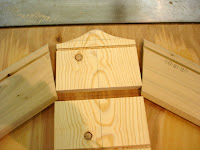
I have found most of my animal patterns in children's coloring books. I transfer them to 1/8 inch fiber board or plywood and cut them out on the scroll saw. I can then easily trace them onto the wood for cutting out.

Here's an example of a cheetah and an elephant pattern in use. Starting at the left is the pattern. Next the cutout and the finished painted animal.

I generally use the rotary tool with a 1/2 inch sanding sleeve to shape the animals. I have found that the sanding dust from Redwood and Cedar can be a bit toxic, so I use a good dust collector to pull the dust away from me.




In these photos of the cheetah you can hopefully see how I use the rotary tool and the sanding sleeve to shape the cheetah. After I cut the blank out, I start at the neck area and lay the 1/2 inch sanding sleeve on the wood and make a concave "cut". Then I do the exact same thing of the other side of the blank. Next, I remove wood to shape the tail. After the tail I generally move to the legs. Remove some wood in front of the rear legs and then behind the front legs. Then you can just round off the areas between the tail and the neck cut. Finally, use the sanding sleeve to make the cuts that define the cheetahs face.
You can put as much detail in as you wish. But remember, children may not notice, and too much detail may tend to break off when played with. Experience has told me not to separate the animals legs, as they tend to break off.
After shaping the animals with the sanding sleeve, I dip the animal into shellac and let dry. After the shellac is dry, I use acrylic paints for the color.

















































